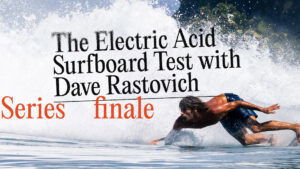Joyride: The Fin Construction Test
Flexy or stiff, flat v. foil — let’s solve this riddle once and for all.
Ed note: See the bottom of the page for your chance to win your own Honeycomb and Blackstix fins from Futures.
This was supposed to be a three-board quiver review*.
Last winter, Wade Tokoro shaped a knife-edged trio for my yearly Hawaiian lap, ranging from 6’4 to 5’7.
Though beautiful, the Tokoros surfed unlike any Hawaiian-made boards I’d ridden prior. Rather than solid and stable, the Tokoros were extremely sensitive and tippy, which led to some uneasy moments in the large and powerful surf.
But the more I rode the boards, I realized that their sensitivity was more of a benefit than a liability. Rather than simply getting to the end of waves with a couple safe direction changes, the Tokoros let me transition from rail to rail and turn on a dime. And the further I pushed them, the better they went.

This makes sense, when you consider how technically Kelly Slater (who rides Tokoros exclusively in Hawaii) surfs at Pipe and Backdoor. Bobbing, weaving, micro and macro adjustments in and around the tube — this is the type of surfing that Tokoros desire. If you’re a “set it and forget it” type of surfer, look elsewhere. These boards scoff at certainty, preferring to dance whimsically on the line between life and life support.
…Which is great, but it also has a downside.
After performing some of my better turns in larger surf (very low bar), the 6’4 snapped in its first session on a routine kickout. Then the 5’11 creased on an unremarkable closeout.
Turns out, this “sensitivity” comes at a cost — boards that are more responsive tend to be more lightly glassed and therefore susceptible to breaking. Just another one of life’s infuriating give-and-takes.
And so, without enough photographic evidence to justify a three-board review, but still wanting to shed some light on these finely-tuned Tokoros, I decided to use the last board standing — a 5’7 5 model — to highlight a different aspect of the surfing experience.
Fins.
Let’s Talk About Fins
Last year, we did a fun test (see above) examining the difference between Futures’ Rake, Neutral, and Pivot templates in their Legacy Series.
The fact that a fin’s shape can drastically change the performance characteristics of a surfboard shouldn’t have surprised me, but it did.
This time, Futures wanted us to test fins with the same outline but in different constructions — one a little flexier than the other.
Again I didn’t think I’d notice that much of a difference. Again I was wrong.
Honeycomb is Futures best-selling fin construction. They consider it a solid starting point for most surfers because it has a “balanced” flex, meaning it’s not too flexible or too stiff — it’s just right.
Their Blackstix construction is a little more frisky. Not only is it flexier than Honeycomb, but all Blackstix fins come with a deep foil (a concave carve-out on the inner face of the fin). Due to hydrodynamic principles that I won’t pretend to understand, the foil helps generate speed — paired with a flexier construction, that means more explosive, dynamic surfing in weaker waves.

The Verdict
Both in the pool and the ocean — and riding the same fin templates for apples-to-apples comparisons — I was beside myself at how different the Honeycomb and Blackstix constructions felt from one another.
The Honeycombs were solid and reliable, but noticeably slower and stiffer than the Blackstix. The Blackstix were incredibly quick and explosive, but handled power and surface texture far worse than the Honeycombs.
Perhaps the best comparison would be to PU vs. EPS surfboards (Joyride on this topic coming soon). The Honeycombs are PU — consistent across all conditions but definitely thrive in the juice; the Blackstix are EPS — absolutely electric in small, clean surf, but can be overwhelmed by power and/or chop.
For the conditions I surfed in this test, the Blackstix reigned supreme. But the waves are overhead at home right now, and I wouldn’t dare stray from my Honeycombs.
How to win 6 new sets of Futures Fins
Email us at [email protected] (subject line: Flex) with the following info for your chance to win.
Name:
Age:
Where you’re from:
What’s a time that you wish you would have been more flexible?
Bonus: Include a photo of yourself surfing
Here’s the winner of a previous Joyride board giveaway, Lucas Zender, and his new Channel Islands NB3.

Previous winners include:
Amy Markham: Haydenshpes Cohort_I
Blair Overton: Rusty Keg
Angus Farrell: DHD Mini Twin
Adrian Hellman: LSD Hammer
Isaac Plunkett: Haydenshapes HK Twin
Jourdan Davis: JS Blak Box III
Jeremy Pether: Lost Rad Ripper
Ashley Uy: Surfboard Broker x Ghostshapes
Cudi von Pup: Haydenshapes Raven
Jay Piper-Healion: Pyzel Mini Ghost
Murray Wardrop: Channel Islands Twin Pin
Aidan McCall: Rusty Miso
Kalani Lucas: Panda Shrizz
Lucas Zender: Channel Islands NeckBeard 3
Gabe Federico-Matthews: JS Black Baron 2.1
Reef Hutabarat, Jared Wallach and Joe Bracegirdle: Futures Legacy Series x CI Pro
Dash Dunkell: KT Surfboards
Sean Gibbons: Pagan Modern Twin
Luke Kewming: Rusty D-Min
Ryan Byor: SMTH Shapes Hooligan
Dave Norman: ACSOD Blue & Red Lotus
*After testing three-board quivers from Eric Arakawa, Jon Pyzel, and Glen Pang (the best!) in previous North Shore seasons, Wade Tokoro was the next local shaper on my hit list. Unfortunately 2/3 broke (happens in Hawaii), so we made this Joyride on the Tokoro 5 model instead.















Comments
Comments are a Stab Premium feature. Gotta join to talk shop.
Already a member? Sign In
Want to join? Sign Up